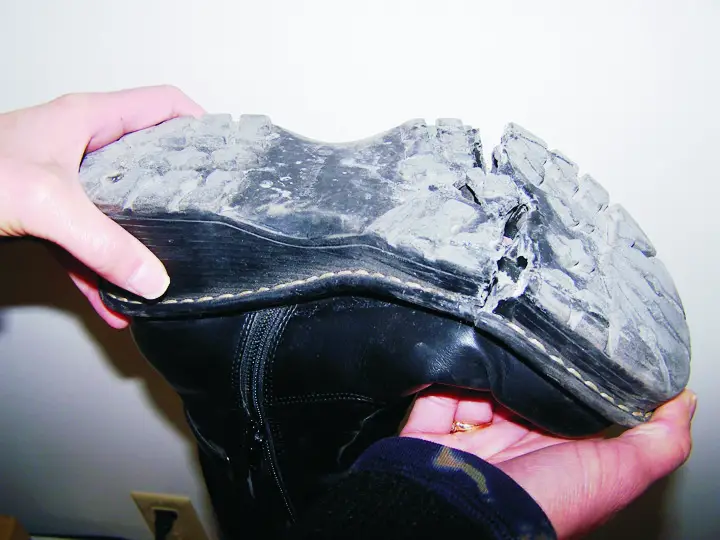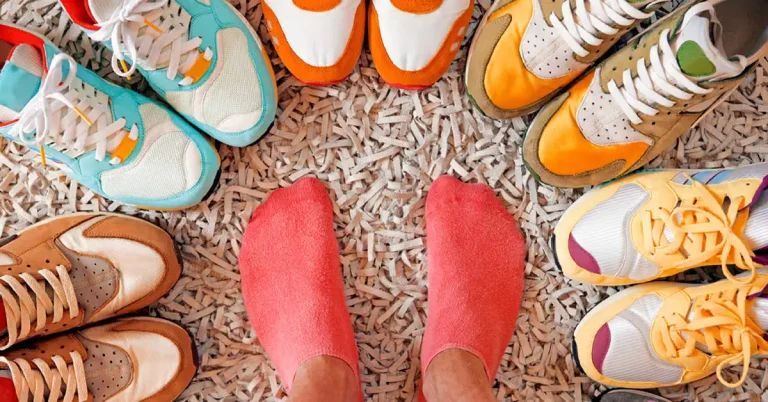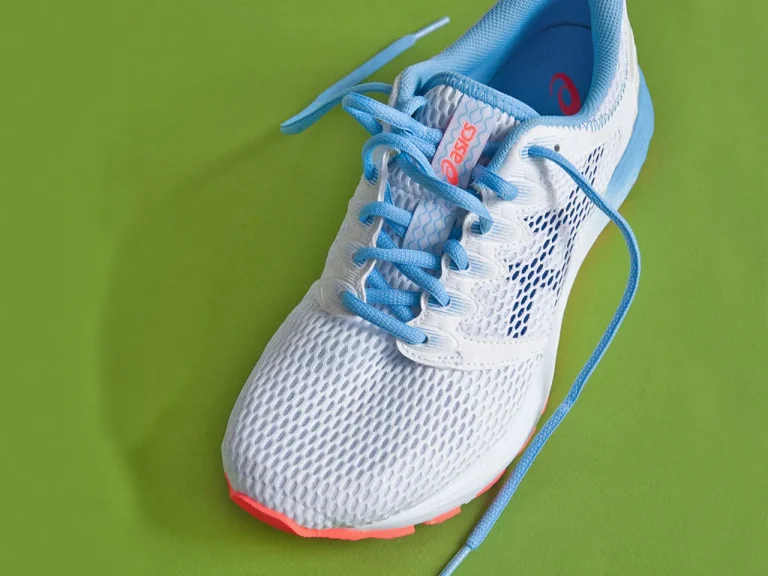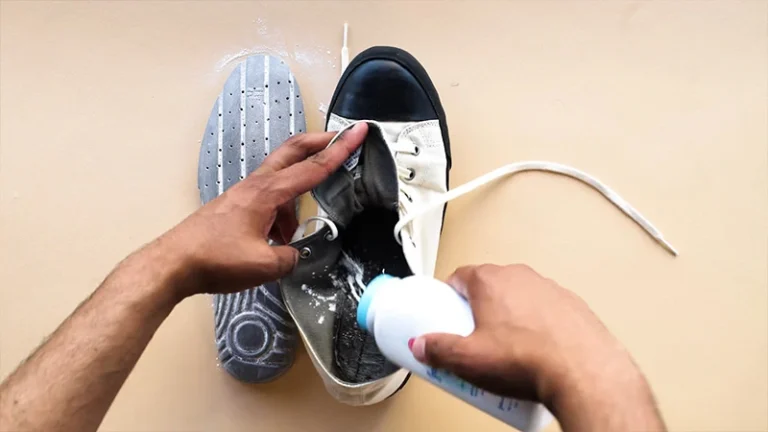How To Fix A Cracked Sole Of A Shoe?
Introduction Of This Topic:
When it comes to fixing a cracked sole of a shoe, timely repair is crucial to ensure the shoe’s longevity. A cracked sole not only affects the shoe’s aesthetics but also compromises its functionality. To address this issue, several simple steps can be followed. Firstly, clean the sole and remove any loose debris. Next, apply a strong adhesive or shoe glue specifically designed for sole repairs. Press the cracked parts together firmly and let the adhesive dry completely. Additionally, reinforcing the repair with a sole patch or stitching can provide extra durability. Regular maintenance and avoiding excessive wear and tear will help prevent future cracks in shoe soles. In this guide i will teach you how to fix a cracked sole of a shoe.
How To Fix Cracked Shoes?
To fix cracked shoes, follow these steps:
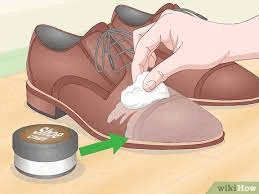
Clean the shoes
Start by removing any dirt, dust, or debris from the cracked area using a soft brush or cloth. Ensure the surface is clean and dry for proper adhesion.
Choose the right adhesive
Select a suitable adhesive designed for shoe repairs. Look for one that works well with the shoe material, such as shoe glue or an adhesive specifically made for leather, rubber, or other shoe types.
Apply the adhesive
Squeeze a small amount of adhesive onto a clean, disposable surface or directly onto the cracked area. Use a toothpick or a small brush to apply the adhesive evenly along the crack.
Press and hold
Gently press the cracked parts together, aligning them as closely as possible. Apply firm pressure for a few minutes to ensure a secure bond. You may also use clamps or heavy objects to hold the cracked area in place while the adhesive sets.
Allow drying time
Follow the manufacturer’s instructions regarding the drying time. It usually takes a few hours or overnight for the adhesive to fully cure. Avoid wearing or using the shoes until the adhesive has completely dried.
Reinforce if necessary
For added durability, consider reinforcing the repaired area with a shoe patch or stitching. This can help prevent future cracks and strengthen the sole.
Remember, each shoe repair may vary depending on the materials and extent of damage. If you’re unsure or dealing with a complex repair, it’s advisable to consult a professional cobbler or shoe repair service.
Related To: How To Get Paint Off Of Leather Shoes?
Related To: How To Make Shoes Smaller Without Insoles?
How To Fix Cracked Shoe Sole?
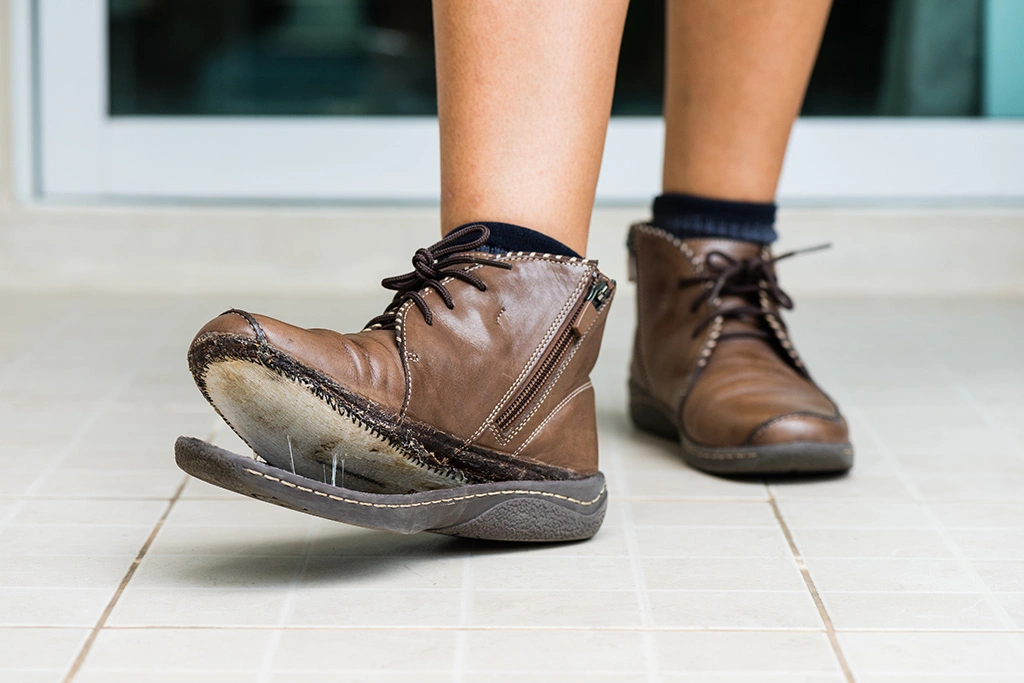
Fixing a cracked shoe sole can help extend the life of your footwear. Here’s a step-by-step guide to repairing a cracked shoe sole:
Clean the sole
Remove any dirt, dust, or debris from the cracked area using a soft brush or cloth. Ensure the surface is clean and dry before proceeding.
Assess the crack
Evaluate the size and severity of the crack. If it’s a small, shallow crack, you can proceed with a DIY repair. However, for larger or more significant cracks, it’s recommended to seek professional shoe repair services.
Apply a shoe adhesive
Select a strong adhesive specifically formulated for shoe repairs. Apply a generous amount of adhesive along the crack, making sure to cover the entire affected area.
Press and hold
Gently press the cracked parts of the sole together, aligning them as closely as possible. Apply firm and even pressure for a few minutes to ensure a secure bond.
Let it dry
Follow the manufacturer’s instructions regarding drying time. Typically, it takes several hours for the adhesive to fully dry and cure. Place the shoe on a flat surface and avoid putting weight on the repaired sole during this time.
Optional reinforcement
To reinforce the repaired sole, you can use a shoe patch or sole protector. These can be found at shoe repair stores or online. Apply the patch according to the manufacturer’s instructions for added strength and durability.
Important Note:
It’s important to keep in mind that a DIY repair may not be as long-lasting or effective as professional repairs. If the crack is extensive or the shoe is of high value, it’s advisable to consult a professional cobbler or shoe repair service for the best results.
Shoe Crack Repair Kit
While there isn’t a specific “Shoe Crack Repair Kit” available on the market, you can still repair cracks in your shoes using a few basic tools and materials. Here’s a general guide on how to repair shoe cracks:
Materials you will need:
- Shoe adhesive or strong glue suitable for the shoe material (e.g., Shoe Goo, E6000, Barge Cement).
- A small brush or applicator to apply the adhesive.
- Clamps or binder clips.
- Sandpaper (fine-grit).
- Optional: Leather conditioner or shoe polish (if the shoes are made of leather).
Step-by-step process
It’s important to note that the success of the repair will depend on the severity of the crack and the type of shoe material. This method works best for small to moderate cracks. If the crack is extensive or the shoe material is severely damaged, it may be more practical to consult a professional cobbler or consider replacing the shoes.
Related To: Best Running Shoes For Treadmill
How To Fix Cracked White Leather Shoes
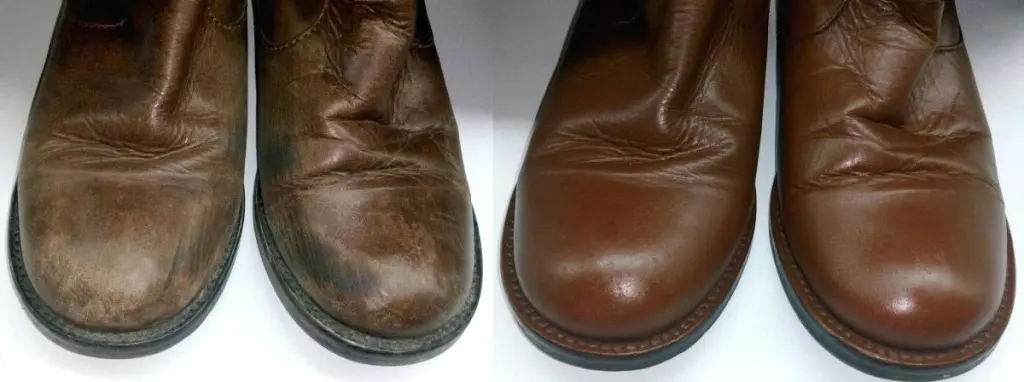
To fix cracked white leather shoes, you can follow these steps:
Materials you will need:
- Leather cleaner or mild soap (such as saddle soap).
- Soft cloth or sponge.
- Leather conditioner or moisturizer.
- Shoe adhesive or leather glue.
- Small brush or applicator.
- Sandpaper (fine-grit).
- White leather paint (if needed).
Step-by-step process:
Clean the shoes
Start by cleaning the cracked area and the entire shoe. Use a leather cleaner or mild soap mixed with water to remove any dirt, stains, or oils. Gently scrub the surface with a soft cloth or sponge. Rinse off the soap and let the shoes dry completely.
Prepare the cracked area
If there are loose or flaky bits of leather around the crack, trim them off with a pair of scissors. Then, gently sand the cracked area with fine-grit sandpaper. This will help smooth out the surface and improve adhesion.
Apply leather adhesive
Using a small brush or applicator, apply a thin layer of shoe adhesive or leather glue to the cracked area. Make sure to spread the adhesive evenly and cover the entire crack.
Press the crack together
Carefully press the cracked edges together, applying even pressure to ensure they adhere properly. You can use your fingers or a clamp to hold the edges in place while the adhesive dries. Follow the instructions on the adhesive for the recommended drying time.
Trim and touch up
After the adhesive has dried, inspect the repaired area. If there are any excess adhesive or uneven surfaces, carefully trim or sand them down to create a smooth finish.
Condition the leather
Apply a leather conditioner or moisturizer to the entire shoe, including the repaired area. This will help restore moisture and flexibility to the leather and prevent future cracking.
Paint touch-up (if needed):
If the crack is still visible after the repair, you can use white leather paint to touch up the area. Apply the paint with a small brush, following the instructions on the paint bottle. Allow the paint to dry completely before wearing the shoes.
Leather Shoe Crack Filler
When it comes to filling cracks in leather shoes, you can use a leather crack filler or a suitable alternative. Here’s a general process for filling cracks in leather shoes:
Materials you will need:
- Leather crack filler or leather repair compound.
- Applicator or spatula for applying the filler.
- Sandpaper (fine-grit).
- Leather conditioner or moisturizer.
- Optional: Leather paint (if needed for color matching).
Step-by-step process
Clean the shoes
Begin by cleaning the cracked area and the entire shoe. Use a leather cleaner or mild soap mixed with water to remove dirt and grime. Gently scrub the surface with a soft cloth or sponge. Rinse off the soap and let the shoes dry completely.
Prepare the cracked area
If there are loose or flaky bits of leather around the crack, trim them off with a pair of scissors. Then, gently sand the cracked area with fine-grit sandpaper. This will help smooth out the surface and create better adhesion for the crack filler.
Apply the crack filler
Using an applicator or spatula, apply the leather crack filler or leather repair compound to the cracked area. Follow the instructions provided with the specific product for the best application method. Ensure that the filler is spread evenly and fills the entire crack.
Smooth and level the filler
After applying the filler, use the applicator or spatula to smooth and level the surface. Try to match the contour of the surrounding leather as much as possible. Remove any excess filler around the crack.
Let the filler dry
Allow the crack filler to dry according to the instructions provided with the product. The drying time may vary depending on the specific filler used.
Sand and blend
Once the filler has dried, gently sand the repaired area with fine-grit sandpaper. This will help to blend the filled crack with the surrounding leather and create a smoother finish.
Condition the leather
Apply a leather conditioner or moisturizer to the entire shoe, including the repaired area. This will help nourish and protect the leather, keeping it supple and preventing further cracking.
Optional
Paint touch-up (if needed): If the filled crack doesn’t match the color of the shoe, you can use leather paint to touch up the area. Apply the paint with a small brush, following the instructions on the paint bottle. Allow the paint to dry completely before wearing the shoes.
It’s important to note that the success of the repair may depend on the severity of the crack and the condition of the leather. For significant damage or extensive cracks, it’s advisable to consult a professional cobbler or consider replacing the shoes
How To Repair Cracked Vinyl Shoes
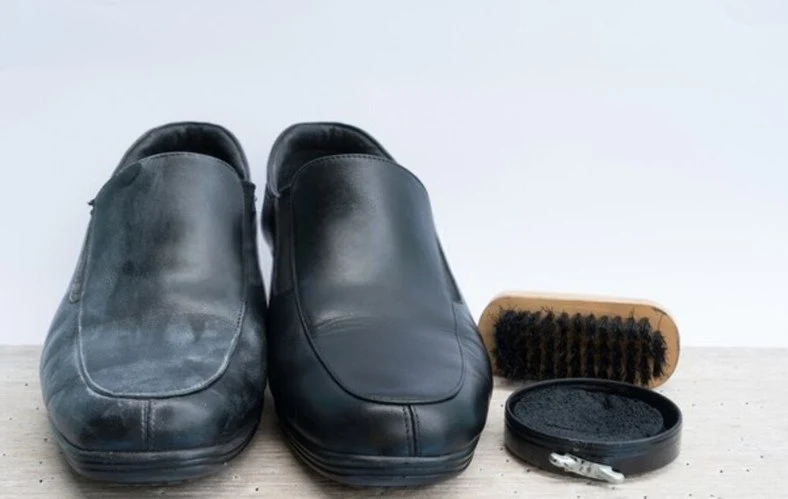
To repair cracked vinyl shoes, you can follow a few steps to restore their appearance and prolong their lifespan. First, clean the shoes using a mild soap or vinyl cleaner to remove any dirt or debris from the cracks. Gently scrub the surface with a soft cloth or sponge and rinse off any residue. Once the shoes are dry, apply a vinyl repair compound or adhesive specifically designed for vinyl materials. Use a small brush or applicator to spread the compound evenly over the cracks, ensuring that they are completely filled.
Allow the repair compound to dry according to the manufacturer’s instructions. Once dry, you can sand the repaired area lightly with fine-grit sandpaper to create a smoother finish. Finally, apply a vinyl conditioner or protectant to the entire shoe to restore flexibility and prevent future cracking.
It’s important to note that while these steps can improve the appearance and functionality of cracked vinyl shoes, they may not completely restore them to their original condition. If the cracks are severe or the vinyl material is extensively damaged, it may be more practical to consider replacing the shoes.
Kekao Sneaker Crack Solution
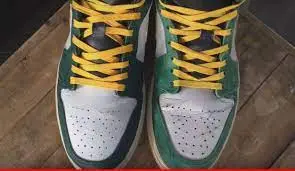
I’m sorry, but I couldn’t find any specific information about a product called “Kekao Sneaker Crack Solution” in my training data up until September 2021. It’s possible that this is a new product or a brand that has emerged after my knowledge cutoff. If you have any specific details or instructions regarding the “Kekao Sneaker Crack Solution,” I’ll be happy to help you with general advice on repairing sneaker cracks or suggest alternative solutions.
Can Cracked Shoes Be Repaired?
Yes, cracked shoes can often be repaired, depending on the severity of the cracks and the shoe material. The repair method may vary based on the type of shoe and the extent of the damage. For small cracks, using a strong adhesive or glue designed for the specific shoe material can often fix the issue. By applying the adhesive and firmly pressing the cracked edges together, you can restore the integrity of the shoe. For more extensive cracks or damage, seeking the assistance of a professional cobbler is recommended.
They have the expertise and tools to assess the damage and provide appropriate repairs, such as stitching, patching, or replacing damaged sections. It’s worth noting that the success of the repair will depend on factors such as the shoe material, the age of the shoes, and the overall condition. In some cases, particularly if the shoes are severely damaged or the cracks are irreparable, it may be more practical to consider replacing them.
Is There a Way to Fix Cracked Leather Shoes?
Yes, there are ways to fix cracked leather shoes. Here are some methods you can try:
Leather conditioner and moisturizer:
Start by cleaning the shoes with a leather cleaner or mild soap. Once they are dry, apply a high-quality leather conditioner or moisturizer to the cracked areas. These products can help hydrate the leather and reduce the appearance of cracks. Follow the instructions on the conditioner or moisturizer for the best results.
Leather repair kits:
There are leather repair kits available that come with specific products for fixing cracks in leather. These kits typically include a leather filler or adhesive that can be used to fill in and repair the cracks. Follow the instructions provided with the kit to apply the filler and blend it with the surrounding leather.
Shoe polish or leather dye:
Using shoe polish or leather dye that matches the color of your shoes can help hide the appearance of cracks. Apply the polish or dye to the cracked areas and buff them gently to blend in with the rest of the shoe.
Professional repair:
If the cracks are extensive or you are unsure about fixing them yourself, it’s advisable to take your shoes to a professional cobbler or leather repair specialist. They have the expertise and tools to assess the damage and provide appropriate repairs, such as stitching or patching the cracks.
Remember, the success of repairing cracked leather shoes depends on the severity of the cracks and the condition of the leather. If the cracks are severe or the leather is significantly damaged, professional repair or replacement may be the best option.
Why is My Shoe Cracking?
There can be several reasons why your shoe is cracking. Here are a few possible factors that can contribute to shoe cracking:
Age and Wear
Over time, shoes naturally go through wear and tear. The materials, such as leather or synthetic materials, may become more brittle and prone to cracking as they age. If you have been using the shoes for an extended period or they have experienced heavy use, the cracking could be a result of this natural deterioration.
Dryness and Lack of Moisture
Shoes, especially those made of leather, require regular conditioning and moisturizing to maintain their flexibility and prevent cracking. If the shoes have not been properly cared for or exposed to excessive dryness, such as from heat or sunlight, the lack of moisture can cause the leather to dry out, stiffen, and crack.
Incorrect Storage
Improper storage can also contribute to shoe cracking. Storing shoes in environments that are too hot, cold, humid, or dry can affect the materials and lead to cracking. Shoes should be stored in a cool, dry place, away from direct sunlight or extreme temperature fluctuations.
Poor Quality Materials
Shoes made with low-quality or inferior materials may be more prone to cracking. Inferior leather or synthetic materials may not have the durability and flexibility required to withstand regular use, leading to premature cracking.
Incorrect Fit or Improper Use
Shoes that do not fit properly or are used in activities they are not designed for can also lead to cracking. If the shoes are too tight or too loose, it can cause undue stress on the materials, leading to cracking. Similarly, using shoes meant for specific activities in different contexts can accelerate wear and tear, making them more susceptible to cracking.
To prevent or minimize shoe cracking, it is important to properly care for your shoes. Regularly clean and condition leather shoes, store them in suitable conditions, and ensure they fit properly. Additionally, investing in high-quality shoes made from durable materials can help reduce the likelihood of cracking.
Can A Cracked Sole Be Fixed?
In many cases, a cracked sole can be fixed or repaired, depending on the severity of the crack and the shoe construction. Here are a few potential methods for repairing a cracked sole:
Shoe Glue or Adhesive:
If the crack is small or superficial, you can try using a shoe glue or adhesive specifically designed for sole repairs. Clean the cracked area thoroughly, apply the adhesive, and press the cracked edges together firmly. Follow the adhesive manufacturer’s instructions for drying time and any additional steps.
Sole Patches or Inserts:
For larger cracks or more extensive damage, sole patches or inserts can be used to reinforce and repair the cracked area. These patches are typically made of durable materials like rubber or synthetic compounds. Clean the cracked area, apply adhesive to both the sole and the patch, and press them together firmly. Again, follow the instructions provided with the patches or inserts for best results.
Shoe Repair Professional:
If the crack is significant, or if you’re uncertain about repairing it yourself, it’s recommended to seek the assistance of a professional shoe repair service or cobbler. They have the expertise and specialized tools to assess the damage and provide appropriate repair options, which may include stitching, patching, or sole replacement.
It’s important to note that the success of the repair will depend on the condition of the sole, the severity of the crack, and the quality of the repair materials used. In some cases, particularly if the sole is extensively damaged or the crack is irreparable, it may be more practical to consider replacing the shoes or consulting a professional for their expert opinion.
Conclusion
A cracked sole can often be repaired depending on the extent of the damage. Small cracks can be fixed using shoe glue or adhesive, while larger cracks may require the use of sole patches or inserts. Seeking the help of a professional shoe repair service or cobbler is recommended for significant or complex repairs. However, it’s important to consider the severity of the crack and the overall condition of the sole when determining the feasibility of repair. In some cases, replacement may be the best option for severely damaged soles.

